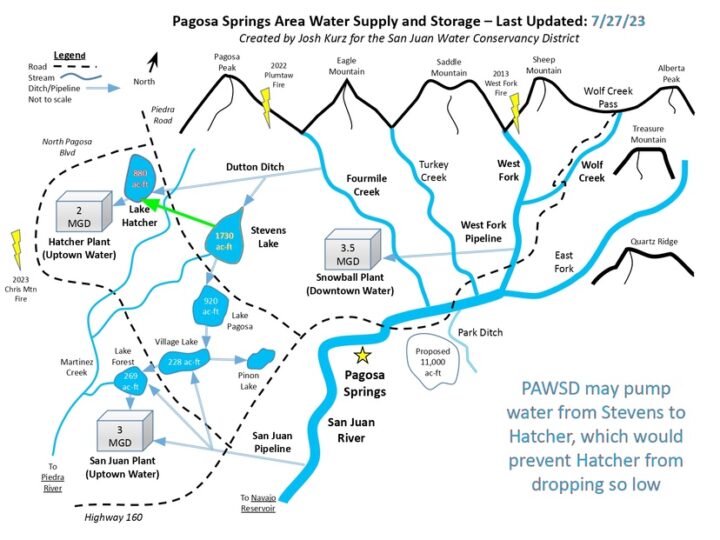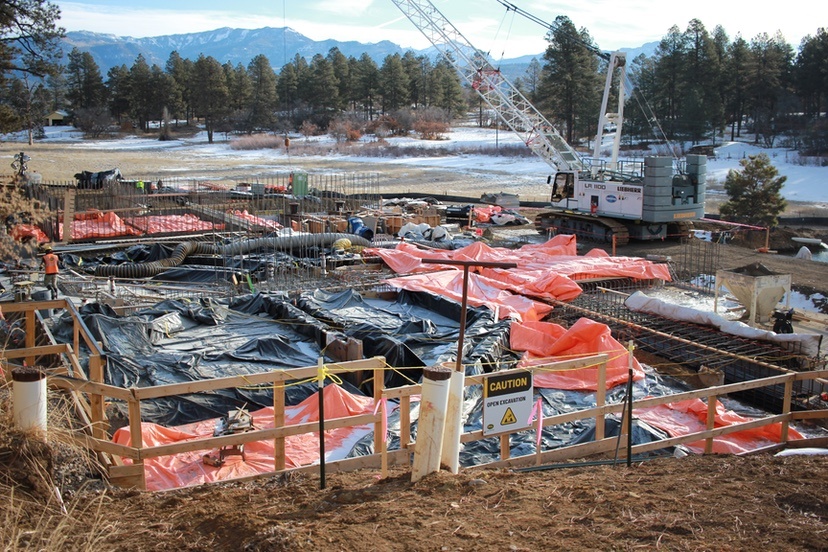PHOTO: The new PAWSD water treatment plant on Snowball Road, under construction, January 3, 2024.
We have a lovely community, here in Pagosa Springs, except for the things that aren’t so lovely.
We don’t all agree about which things belong in each category.
I had the pleasure to sit down with a local activist yesterday, over coffee, to discuss one of the most contentious topics in the American West: water. Not a new controversy, by any means, but one that took on added meaning in the 21st century, both here in Pagosa Springs and across the West.
Regionally, a 20-year change in precipitation patterns and an over-consumption of resources — mainly by Arizona and California — has resulted in threats to the nation’s two largest man-made reservoirs, Lake Mead and Lake Powell. Ongoing talks among the states the contribute to and use the water from those reservoirs might result in solutions. Or maybe not.
For the first time, these water negotiations have included input from tribal groups who were granted water rights more than 100 years ago.
Locally, the precipitation changes led to what I’ve often referred to here in the Daily Post as the Dry Gulch boondoggle — the joint purchase, by the San Juan Water Conservancy District (SJWCD) and Pagosa Area Water and Sanitation District (PAWSD) of 660 acres just northeast of downtown Pagosa, as the site for a future water reservoir. The two water districts — citing studies by water engineer Steve Harris — claimed that Pagosa Springs would be desperately short of water by 2020, and paid $10 million in 2008 for ranch property in the Dry Gulch valley — the Weber family’s Running Iron Ranch, which was probably worth $3 million at the time.
The two districts additionally allowed the Weber family to mine gravel on the property for 15 years, for a lease payment of $1 per year.
Disclosure: I currently serve as a volunteer on the PAWSD board of directors, but this editorial reflects only my own opinions and not necessarily the opinions of any other board members or of the board as a whole.
The two water districts went through a nasty divorce in about 12 years ago, and adopted very different policies concerning the need for a Dry Gulch reservoir.
During 2023, the two water districts continued to disagree about the Running Iron Ranch. Without any approval or agreement from PAWSD, the SJWCD has adopted a tentative plan to build an 11,000 acre-foot reservoir on the ranch property.
And without any approval or agreement from SJWCD, the PAWSD board adopted a tentative plan to use part of the ranch property for workforce housing.
What does our community need most? Affordable housing options…. or a reservoir seven times the size of Lake Hatcher?
Maybe we need both? And perhaps both are very difficult to bring about?
It’s not unusual to find people in Pagosa wondering how secure our water supplies might be, when the mainstream media is full of talk about a warmer, drier climate. But in fact, water is something that Pagosa Springs seems to have plenty of, for the time being, in spite of what water engineer Steve Harris predicted in 2007. If you want to learn more about our local water supplies, SJWCD posted a series of informative pages on their website earlier this year… although the information paints a somewhat less positive picture of the community’s water situation than what we’ve generally shared here in the Daily Post.
Here’s one of the slides from that online SJWCD essay.

The photo shown at the top of this editorial shows the $40 million Snowball water treatment plant under construction, a project that was estimated at $25 million just a few years ago. To build this project — a replacement for the aging PAWSD treatment plant at that same location — PAWSD obtained a loan from the state of Colorado, which water customers will be paying off over the next 30 years through their monthly water bills. Like the existing plant, this new facility will process water piped in from the West Fork of the San Juan River… some of the cleanest water in the United States, but still in need of treatment to meet state drinking water standards.
The old treatment plant has been using an outdated technology which resulted in much of the treated water being wasted in a back-flushing process.
The West Fork water rights allow PAWSD to divert 5 CFS (cubic feet per second) from the San Juan River, but the old plant was able to treat less than 2 CFS. The specs for the new plant suggest it will be able to treat the full 5 CFS when required.
To put those numbers into perspective, if the plant were to treat 5 CFS year round, that would amount to about 3,622 acre feet per year. PAWSD sells about 1,300 acre feet per year. So the new plant would theoretically be able to service a community three times the current population of Pagosa Springs, plus three times the number of tourists.
Currently, however, the Hatcher treatment plant on the shores of Lake Hatcher serves the majority of PAWSD customers, with separate water rights on Fourmile Creek. The Hatcher plant typically treats about 1,200 acre feet per year — almost enough for the entire community — but due to leaks in aging PAWSD water lines, the community loses about 35% of its treated water. (PAWSD has an ongoing program to fix the leaks.)
Between the Hatcher plant and the new Snowball plant, it appears that treated drinking water will not be a big concern for Pagosa. The community could easily quadruple in size without running out of water resources.
Nevertheless, San Juan Water Conservancy District continued, during 2023, to plow ahead with plans to build a reservoir seven times the size of Lake Hatcher, mainly because SJWCD happens to hold a water right that theoretically allows for a reservoir that size. SJWCD does not deliver water to anyone, and has no practical way to finance an 11,000 acre-foot reservoir… and the water right actually belongs to the Pagosa community… but that’s government for you.
At the present moment, the PAWSD board and the SJWCD view the future of our water resources through very different lenses.

